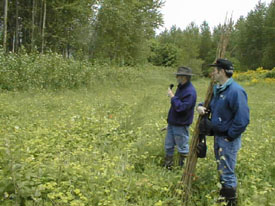Active Management Best Way to Enhance Functional Values of Riparian Buffers
Photo: M. Merwin
By Michael Maki, Natural Resources Consultants, Seattle, WA
Editor's Note: The following is adapted from a consultant's report concerning the unique agricultural buffer plan in Skagit County, WA which was drafted in response to the Washington State Growth Management Act’s attempts to protect "critical" habitat for salmon congruent with the Endangered Species Act listings of Northwest salmon. See the April 2000 issue of the Temperate Agroforester for related stories.
A buffer may be defined as an area that protects another area from negative impacts or influences, a kind of neutral zone of insulation. In agricultural areas buffers may be seen and defined from two perspectives: as a buffer on the effects of agricultural practices on adjacent water bodies, and as a linear habitat zone surrounding streams and creating a microclimate similar to natural conditions. Currently, there is a popular environmental belief that the best approach to the conservation of riparian areas is passive management, leaving vegetation to re-establish itself through natural processes. In forested areas the natural re-establishment of vegetation connected with streamside forested leave strips maybe a practical and viable solution. However, this approach does not well serve salmon habitat in areas thoroughly altered by agricultural practices or other human development.
- Details
- Written by Tyler Carlson
- Parent Category: 2001 Vol. 9
- Category: October No. 4




